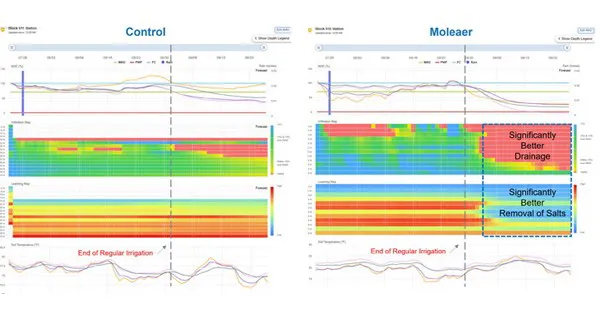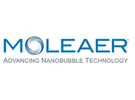Maricopa Orchards, a family-owned farm in Fresno, California growing mostly pistachios and almonds, was able to increase water infiltration into the soil which aided in salts leaching after adding Moleaer’s XTB™ nanobubble generator with oxygen nanobubbles.
Like most farms in the Sacramento Delta, Maricopa struggled with reduced water allocations, increased drought conditions and declining soil conditions from elevated levels of sodium, boron, chloride and bicarbonate salts brought in from well water. High levels of salinity in the soil negatively impact plant health and are attributed to crop reduction.
A common way to combat high salinity is to leach the salts below the root zone. But with poor infiltration, this was not always possible.
Instead, Maricopa applied gypsum to the soil to break up clay particles and improve infiltration. This process can be costly with materials and labor, and applying too much gypsum can eliminate beneficial nutrients like magnesium, iron and manganese.
Maricopa sought a sustainable way to achieve better infiltration, improve soil health and leach salts below the root zone.
 Joe Coelho, Maricopa’s agronomy manager, selected Moleaer’s nanobubble technology as a cost-effective solution because it delivers multiple benefits, including:
Joe Coelho, Maricopa’s agronomy manager, selected Moleaer’s nanobubble technology as a cost-effective solution because it delivers multiple benefits, including:
- Reducing the surface tension of water, allowing water to penetrate and infiltrate through the soil more easily.
- Improving flocculation (or the aggregate of clay particles) of soils, improving soil structure and reducing soil compaction.
- Increasing ionic mobility of nutrients in the soil.
- Increasing dissolved oxygen (DO) levels in irrigation water.
- Improving irrigation system hygiene through pathogen and biofilm control.
During a trial period in one of the saltiest areas on the property, Coelho monitored the conditions of the soil, including moisture, infiltration and salt levels at various depths. The nanobubble generator was installed inline in the drip irrigation system with an oxygen tank for pure oxygen gas. Oxygen nanobubbles were then injected directly into the irrigation system around 10 rows with 40 trees per row.
Coelho observed that the nanobubble-enriched water was able to infiltrate down to a depth of 46 inches, compared to 26 for the control water. In addition, Coelho saw that the 46-inch profile of soil was salt-free, showing that nanobubbles aided in leaching the salts below the root zone by reducing soil compaction, improving infiltration and increasing ionic mobility. The initial findings showed a significant improvement in water infiltration and salt leaching.
“With the consideration of many additional benefits, Moleaer’s nanobubble technology shows great promise,” said Coelho. “The product could be a much more comprehensive solution to issues caused by soil and water salinity.”
 For more information:
For more information:
Moleaer
https://www.moleaer.com/
